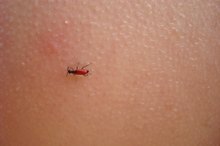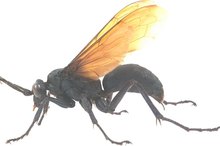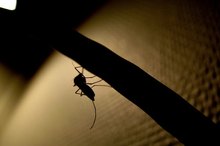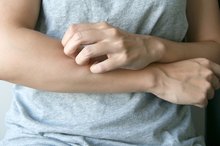How to Identify Insect Bites by Pictures
If you’ve got an itchy or swollen insect bite, chances are you are itching to get rid of it as soon as possible. Identifying the bite can help diagnose how to remedy it, or at least give you peace of mind about the severity of the bite. By using pictures, be they from a bug book or online source, you can easily identify a bug bite to ensure that you take proper care of it and don’t require medical attention.
Check out the actual bite itself, and see if there are one or two holes. If it is two holes, you may want to focus on photos of spider bites, as these typically leave two tiny holes, whereas one hole can indicate another kind of bug. Spider bites can also leave one hole behind, instead of two, so you may still be dealing with a spider culprit even if you only see one hole at the bite area.
How to Identify Insect & Mite Bites
Learn More
Look at the coloration of skin around the bite area. It may, for example, be red, white or even purple. Compare it to pictures from your book or online to find a few that match the coloration of skin around the bite.
Check out the swelling of your bite as well, and use that in hand with the coloration of the area to narrow down your results using the pictures you have selected. For example, you may have a photo with similar coloring, but your bite is much more swollen, so look to the photo that has both the swelling and coloration you have.
How to Tell If You Have a Wasp Bite or Sting
Learn More
Research the bugs that have made the bites in the photos you found that match your bite 1. Find out what regions they reside in and figure out whether, depending on areas you have visited, you could have been exposed to one of them. Chances are you will find one and that is probably the culprit.
Tips
If you’ve narrowed the bite down to a few photos and are having trouble singling out which type of bug made your bite, consult your doctor, who can not only help diagnose, but may also help give you medication for a more speedy recovery. Always protect yourself from bites by using bug spray before going into areas where you know there will be a lot of bug life.
Warnings
If your bite begins to spread rapidly in redness, presents with intense pain, pus or red streaks, seek medical attention immediately. If you’ve been bitten and begin to feel dizzy, nauseous, swollen or have difficulty breathing, seek medical help immediately, as you may have a severe allergy to the bite.
Related Articles
References
- Web MD: Identifying Bugs And Their Bites
- Cedars Sinai Medical Center. Brown Recluse and Black Widow Spider Bites in Children.
- Sotelo-cruz N, Gómez-rivera N. [Neurotoxic manifestations of black widow spider envenomation in paediatric patients]. Neurologia. 2016;31(4):215-22. doi:10.1016/j.nrl.2015.05.007
- Williams M, Nappe TM. Black Widow Spider Toxicity. StatPearls Publishing. Updated March 8, 2019.
- Stoecker WV, Vetter RS, Dyer JA. NOT RECLUSE-A Mnemonic Device to Avoid False Diagnoses of Brown Recluse Spider Bites. JAMA Dermatol. 2017;153(5):377-378. doi:10.1001/jamadermatol.2016.5665
- Vetter RS. The distribution of brown recluse spiders in the southeastern quadrant of the United States in relation to loxoscelism diagnoses. South Med J. 2009;102(5):518-22. doi:10.1097/SMJ.0b013e3181a0abb3
- Illinois Department of Public Health. Brown Recluse and Black Widow Spiders.
- Rahmani F, Banan Khojasteh SM, et al. Poisonous Spiders: Bites, Symptoms, and Treatment; an Educational Review. Emerg (Tehran). 2014;2(2):54-8.
- Gaver-wainwright MM, Zack RS, Foradori MJ, Lavine LC. Misdiagnosis of spider bites: bacterial associates, mechanical pathogen transfer, and hemolytic potential of venom from the hobo spider, Tegenaria agrestis (Araneae: Agelenidae). J Med Entomol. 2011;48(2):382-8. doi:10.1603/ME09224
- Livshits Z, Bernstein B, Sorkin LN, Smith SW, Hoffman RS. Wolf spider envenomation. Wilderness Environ Med. 2012;23(1):49-50. doi:10.1016/j.wem.2011.11.010
- Meires J, Louden B. Bite of the Brown Recluse Spider. Clinical Review. 2010(12):14-17.
- Pagac BB, Reiland RW, Bolesh DT, Swanson DL. Skin lesions in barracks: consider community-acquired methicillin-resistant Staphylococcus aureus infection instead of spider bites. Mil Med. 2006;171(9):830-2. doi:10.7205/milmed.171.9.830
- Mikals K, Beakes D, Banks TA. Stinging the Conscience: A Case of Severe Hymenoptera Anaphylaxis and the Need for Provider Awareness. Mil Med. 2016;181(10):e1400-e1403. doi:10.7205/MILMED-D-15-00536
- Gaver-Wainwright MM, Zack RS, Foradori MJ, Lavine LC. Misdiagnosis of spider bites: bacterial associates, mechanical pathogen transfer, and hemolytic potential of venom from the hobo spider, Tegenaria agrestis (Araneae: Agelenidae). J Med Entomol. 2011 Mar;48(2):382-8.
- Isbister GK, Framenau VW. Australian wolf spider bites (Lycosidae): clinical effects and influence of species on bite circumstances. J Toxicol Clin Toxicol. 2004;42(2):153-61.
- Livshits, Z., Bernstein, B., Sorkin, L., Smith, S., & Hoffman, R. (2012). Wolf Spider Envenomation. Wilderness & Environmental Medicine, 23(1), 49-50. doi:10.1016/j.wem.2011.11.010
- Pagac BB, Reiland RW, Bolesh DT, Swanson DL. Skin lesions in barracks: consider community-acquired methicillin-resistant Staphylococcus aureus infection instead of spider bites. Mil Med. 2006 Sep;171(9):830-2.
- Payne, K., Schilli, K., Meier, K., Rader, R., Dyer, J., & Mold, J. et al. (2014). Extreme Pain From Brown Recluse Spider Bites. JAMA Dermatology, 150(11), 1205. doi:10.1001/jamadermatol.2014.605
- Robinson, J., Kennedy, V., Doss, Y., Bastarache, L., Denny, J., & Warner, J. (2017). Defining the complex phenotype of severe systemic loxoscelism using a large electronic health record cohort. PLOS ONE, 12(4), e0174941. doi:10.1371/journal.pone.0174941
- Stoecker, W., Vetter, R., & Dyer, J. (2017). NOT RECLUSE—A Mnemonic Device to Avoid False Diagnoses of Brown Recluse Spider Bites. JAMA Dermatology. doi:10.1001/jamadermatol.2016.5665
Tips
- If you've narrowed the bite down to a few photos and are having trouble singling out which type of bug made your bite, consult your doctor, who can not only help diagnose, but may also help give you medication for a more speedy recovery.
- Always protect yourself from bites by using bug spray before going into areas where you know there will be a lot of bug life.
Warnings
- If your bite begins to spread rapidly in redness, presents with intense pain, pus or red streaks, seek medical attention immediately.
- If you've been bitten and begin to feel dizzy, nauseous, swollen or have difficulty breathing, seek medical help immediately, as you may have a severe allergy to the bite.
Writer Bio
Amy Davidson is a graduate from the University of Florida in Gainesville, with a bachelor's degree in journalism. She also writes for local papers around Gainesville doing articles on local events and news.







